Subscribe to Zero-Sum Pfear & Loathing



by Mike Stone | Dec 23, 2022
“Politicians and governments are suppressing science. They do so in the public interest, they say, to accelerate availability of diagnostic treatments. They do so to support innovation, to bring products to market at unprecedented speed. Both of these reasons are partly plausible; the greatest deceptions are founded in a grain of truth. But the underlying behaviour is troubling. Science is being suppressed for political and financial gain. Covid-19 has unleashed state corruption on a grand scale, and it is harmful to public health.”—Kamran Abbasi, executive editor of The BMJ
Throughout the course of this “pandemic,” we have been hit with many scary and alarming headlines alerting the public as to what the latest science says. We’ve seen conflicting studies and flip-flopping reports from the pharmaceutical figureheads painting a frustratingly confusing picture for those attempting desperately to obtain an idea as to what to expect. Information has come at us exceedingly fast and from all sides making it nearly impossible to determine heads or tails of what has been going on. Yet despite the erratic nature of the information presented by the media, there was a constant mantra which has been repeated to us over and over again in an attempt to calm the confusion: trust the science.
We have been told that the data is moving fast and furious and that we are in a fluid situation where the science can change at any given moment. Public health authorities are adapting their thinking based on the newly available data meaning that recommendations and statements could either evolve or revert instantaneously. Thus, we are told that, when conflicting data, studies, and headlines emerge, it isn’t that the science is wrong, it’s that it is in a constantly evolving state where what we know about “Covid” today may not reflect what we know tomorrow. This is especially true in the face of the multitude of variants running around wrecking havoc on all of the data. The minute people gain “immunity” and the vaccines are “proven” effective, studies emerge showcasing a new variant which rises up and takes away said immunity and effectiveness. However, don’t blame the science. The science was not wrong. It mutated…along with the “virus.”
“It is essential as a scientist that you evolve your opinion and your recommendations based on the data as it evolves. And that’s the reason why I say people who then criticize me about that are actually criticizing science.” —Anthony Fauci
Being able to rely on the excuse of the speed of an emerging pandemic has allowed the MSM considerable leeway in promoting studies and data that may not have seen the light of day in the past. We have seen the rise of the preprint era where studies that have not undergone the normal (yet highly flawed) peer review process are given the spotlight. Studies which have never been independently reproduced nor replicated are being championed as evidence and proof of the threat of the “virus.” The unproven conclusions of these studies are being flaunted in the headlines as if the evidence contained within are legitimate scientific facts. However, nothing could be further from the truth. In fact, much of what is considered scientific evidence is in fact false and fraudulent and has been that way for quite some time.
“If you stick with the science, you’re going to have to be prepared to change as the facts evolve. As we communicate what we know, the only thing we can do better is to continue to try to emphasize that we’re dealing with a moving target, and that what we’re telling you now is based on the data as we know it. However, this may change, and we may need to change.” —Anthony Fauci
To highlight this growing problem, I am presenting a few sources over the past three decades which will spotlight many of the issues that have been observed throughout the years which continue to remain unresolved, driving actual scientific pursuit into the ground. You will see that there have been major issues in the sciences that have been known about for quite some time including research biases, selective publications, inappropriate study designs, faulty interpretations, and poor quality control. There is a common theme throughout many of the sources involving the acknowledgement of corrupting forces and conflicting interests which have taken ahold of what is considered scientific research and that most of the results which are published are false and fraudulent. You will see through these sources why the results simply can not be believed and that the science ultimately can not be trusted.
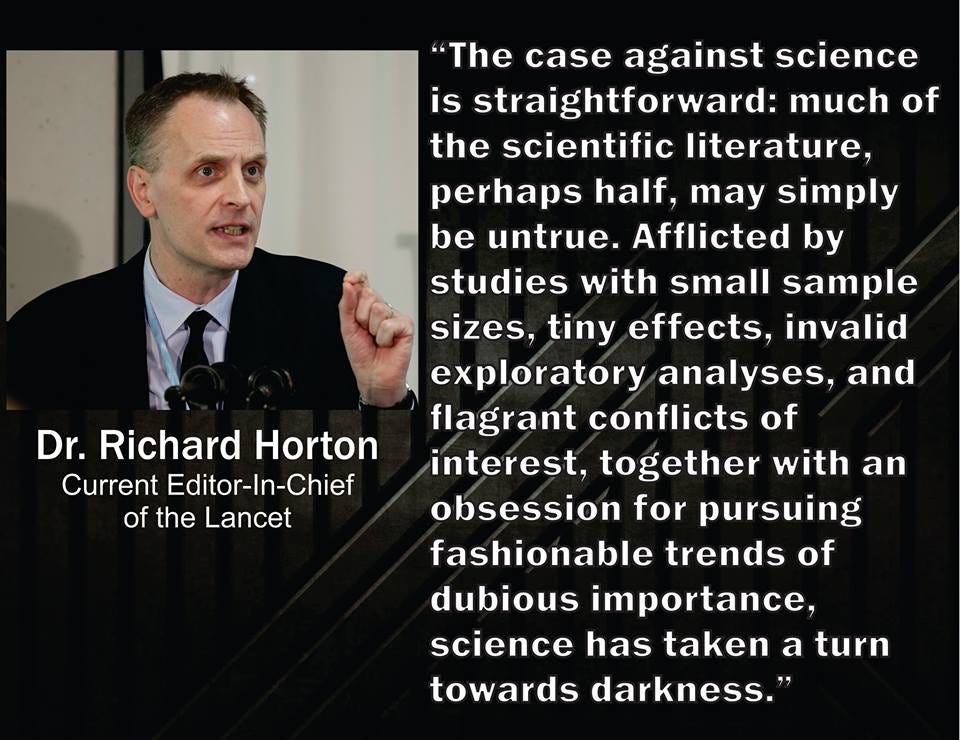
I want to begin with a recent example by sharing excerpts from an article by Dr. Sanjay Gupta (of all people) which came out at the height of this “pandemic” in late June 2020. In Dr. Gupta’s article, he pointed out the problems with the increased acceleration of both the research and the news cycle since the beginning of the “Covid” era. Dr. Gupta addressed the breakneck speed of the MSM to report on the numerous treatments and vaccines that were in development at the time as well as the repurposing of old drugs like Remdesivir to fight this new threat. He took a step back to look at the research supporting these endeavors and admitted that he was surprised by how thin the available data actually was that was being reported on. Dr. Gupta admitted that many of the studies and their findings were not ready for “prime time” and that they were mostly subjective conclusions with accompanying data and methods that were hard to verify and validate.
Dr. Gupta broke the different sources of information into 3 categories: press releases, preprint, and published papers. The press releases are little more than sugar-coated covering for the claims of the manufacturers of the studies of the drugs/treatments which are meant to be picked up and reported on favorably by the press. Preprint studies are meant to elicit feedback from peers before being submitted for publishing in a journal. These types of studies have risen dramatically since the dawn of “Covid” and have led to a great deal of confusion due to the inaccurate headlines and unverified claims made. Published studies, on the other hand, are supposed to be (in theory) the final and complete version which has held up under scrutiny. However, Dr. Gupta admitted that the peer review process these studies undergo is definitely not fool proof and, I may add, is highly flawed. This science by press release and preprint has led to massive confusion and frustration and is admitted by experts within the article to have no place in science. In fact, it is stated that these releases are nothing but “promises with numbers sprinkled on top.” The sheer amount of unproven and unverified studies has flooded the market leading to a “buyer beware” mentality where one can not trust the headlines nor the conclusions being promoted:
“A little more than three months after the World Health Organization officially declared the coronavirus outbreak a global pandemic, it has become evident that both the research cycle and the news cycle have accelerated to levels never seen before in our lifetime.
According to the Milken Institute, there are at least 254 treatments and 172 vaccines currently in development to fight Covid-19. I’ve reported on many of them. Some of them are just being developed, like PAC-MAN, a new anti-viral treatment that uses the gene therapy technology CRISPR. Others are drugs finding a new life, like remdesivir, which initially showed effectiveness in treating animals with SARS and MERS, and was even trialed unsuccessfully for Ebola.
The media’s coverage of these developments has also been at “breakneck speed” – because finding any way to stall the spread of this disease is so imperative. For example, several scientists recently called me both on and off the record to relay their optimism that a vaccine could be available by the beginning of next year. It would be a remarkably fast process, given that vaccine development is typically measured in years or decades, not months. So this past week, I took a step back to dig deeper into the studies and look into the source of this optimism. I was surprised at how thin the available data actually is in peer-reviewed medical journals.”
“But there are also growing concerns – on the part of scientists and journalists – that the studies being offered up and showcased are not ready for “prime time.” In fact, many are not studies at all, but subjective conclusions based on data, and methods that remain hidden and thus difficult to validate. Never before has full and immediate transparency been so important, and never before has the scientific picture around Covid-19 been so opaque.
What difference does the source make?
Press releases, pre-print papers and published papers all serve different purposes, and carry different weight for both scientists and journalists.
A press release “is there to make your institution, your client, your big name researcher, your product, your drug company and its products, look as good as can be, hoping that that press release will convince journalists to write about it,” Gary Schwitzer explained to CNN. Schwitzer is a longtime health journalist and publisher, and the founder of HealthNewsReview.org. Because it’s written by whoever is promoting the product, it’s almost never negative, Schwitzer said.
Traditionally, pre-print papers have been articles that researchers and academics put out on pre-print servers to get feedback from their peers before they submit their study to a journal. During this pandemic, the profiles of at least two of them – medRxiv (pronounced med-archive), for health sciences, and bioRxiv (pronounced bio-archive), for biology – have been greatly elevated. “Pre-print servers are much, much more important than they ever have been in Covid-related areas – in other words, in life sciences, in clinical medicine. They just weren’t a player before this,” Dr. Ivan Oransky told us. Oransky is the co-founder of RetractionWatch.org, Vice President of Editorial at Medscape, and a medical journalism professor at New York University.
A study published in a credible scientific journal is – in theory – the final, complete version. To get published here, a study has to undergo a process called peer review. Kate Grabowski, an assistant professor in the department of pathology at Johns Hopkins University, calls the peer-review process “multiple, independent sets of eyes” on a paper. While peer review is by no means fool-proof, it typically reflects the expertise of many people in a particular field who don’t necessarily have a “dog in the race.”
But the past few months have highlighted that the road to solid science can be full of potholes, speed bumps, blind spots and hairpin turns. If you are not careful, sometimes that road can lead you straight off a cliff.”
“Trying to do science by press release, without backing it up, either with a traditional journal or a preprint … has universally led to misunderstanding and has no place in science. The biotechs are doing it because they’re writing for their shareholders, they’re writing for their investors, but it’s being done in a way that’s oblivious to its public health impact and needs to stop,” Hotez said.
Put another way by frustrated research scientist James Heathers in a tweet: “Science by press release is just promises with numbers sprinkled on it. GIVE. US. THE. GODDAMN. PAPER.”
“Adding to the whiplash and confusion is just the sheer number of studies coming out. According to Grabowski, who based her estimate on the NIH’s iSearch COVID-19 Portfolio, approximately 35,000 articles have been amassed to date on the topic – and they keep coming.
To get a handle on all of them, Grabowski heads up a team of about 50 Johns Hopkins University researchers at the Novel Coronavirus Research Compendium, which curates and reviews emerging research. She estimates they screen between 1,500 and 2,000 articles per week, and have looked at more than 10,000 of them total. As you might expect, some are garbage and some are gems.”
Buyer and seller beware
All the experts said it is great news that so much research is being done, despite the fact that so much of the work is emerging through press releases and pre-prints.
“The fact that scientists are getting work out there earlier so that other scientists can pore over it and we can maybe learn things more quickly – that’s a good thing,” Oransky said. “The fact that we’re treating it all equally as if it’s all been … subject to the same level of scrutiny – that’s the problem.”
Schwitzer cautions journalists and those who disseminate information to take the time to do it right. “Just reminding people to slow down. So much of what we’re doing, reporting breathlessly at breakneck speed, doesn’t need to be reported restlessly at breakneck speed,” he said, adding, “Words matter and the data matter.”
So, what does this all mean for you? “I think that someone reading, viewing, watching, listening should never make any decisions based on a single report they read, whether it’s a study or a news report on a study,” Oransky said. “Particularly if that news report doesn’t put into context everything that’s come before and doesn’t explain what we still don’t know.”
https://www.cnn.com/2020/06/27/health/science-by-press-release-gupta/index.html
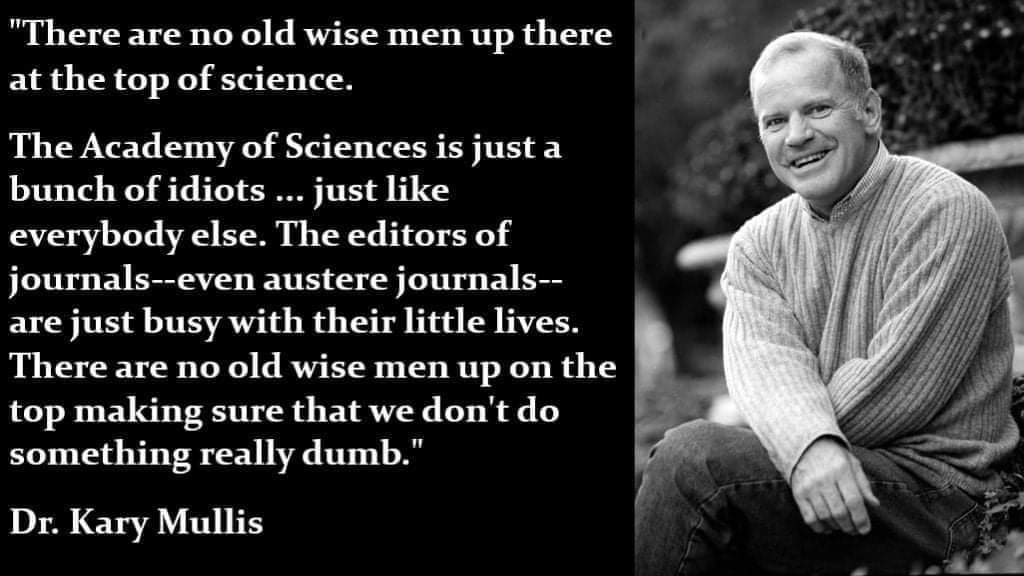
Reading Dr. Gupta’s article makes one wonder how we could have gotten to a place where so much faulty and unverified (pseudo)science is allowed to flourish across the internet. Where are the checks and balances in the medical and scientific journals meant to keep out such junk “science?” What happened to journalistic integrity and why has the media become nothing more than an advertising firm for the pharmaceutical industry? Why are glowing press releases along with unverified and uncorroborated preprint papers being allowed to be reported on as if the conclusions are valid? Could this current problem have been avoided had alarms been sounded prior to this “pandemic?”
Sadly, the issues plaguing the shoddy findings of the scientific community have long been known. Back in 1994, English statistician Douglas Altman wrote an article for The BMJ criticizing the continued publication of fraudulent research. In his editorial, Altman pointed out that the flaws in medical research is a common phenomena that is of a scandalous nature. Huge sums of money is invested in false research consisting of “inappropriate designs, unrepresentative samples, small samples, incorrect methods of analysis, and faulty interpretation.” Doctors and medical researchers are pressured to write studies in order to gain prestige under the understanding that the more studies behind the name, the better it looks professionally irregardless of the quality of the research. They then engage in research that they are ill-equipped to be doing. This has resulted in the problem of scientific fraud that easily goes through undetected creating piles of flawed research. The poor quality of the research is a well understood problem within the industry yet little to no action has been taken in order to correct it:
We need less research, better research, and research done for the right reasons.
What should we think about a doctor who uses the wrong treatment, either wilfully or through ignorance, or who uses the right treatment wrongly (such as by giving the wrong dose of a drug)? Most people would agree that such behaviour was unprofessional, arguably unethical, and certainly unacceptable.
What, then, should we think about researchers who use the wrong techniques (either wilfully or in ignorance), use the right techniques wrongly, misinterpret their results, report their results selectively, cite the literature selectively, and draw unjustified conclusions? We should be appalled. Yet numerous studies of the medical literature, in both general and specialist journals, have shown that all of the above phenomena are common.1 2 3 4 5 6 7 This is surely a scandal.
When I tell friends outside medicine that many papers published in medical journals are misleading because of methodological weaknesses they are rightly shocked. Huge sums of money are spent annually on research that is seriously flawed through the use of inappropriate designs, unrepresentative samples, small samples, incorrect methods of analysis, and faulty interpretation. Errors are so varied that a whole book on the topic,7 valuable as it is, is not comprehensive; in any case, many of those who make the errors are unlikely to read it.
Why are errors so common? Put simply, much poor research arises because researchers feel compelled for career reasons to carry out research that they are ill equipped to perform, and nobody stops them. Regardless of whether a doctor intends to pursue a career in research, he or she is usually expected to carry out some research with the aim of publishing several papers. The length of a list of publications is a dubious indicator of ability to do good research; its relevance to the ability to be a good doctor is even more obscure. A common argument in favour of every doctor doing some research is that it provides useful experience and may help doctors to interpret the published research of others. Carrying out a sensible study, even on a small scale, is indeed useful, but carrying out an ill designed study in ignorance of scientific principles and getting it published surely teaches several undesirable lessons.
In many countries a research ethics committee has to approve all research involving patients. Although the Royal College of Physicians has recommended that scientific criteria are an important part of the evaluation of research proposals,8 few ethics committees in Britain include a statistician. Indeed, many ethics committees explicitly take a view of ethics that excludes scientific issues. Consequently, poor or useless studies pass such review even though they can reasonably be considered to be unethical.9
The effects of the pressure to publish may be seen most clearly in the increase in scientific fraud,10 much of which is relatively minor and is likely to escape detection. There is nothing new about the message of data or of data torture, as it has recently been called11 – Charles Babbage described its different forms as long ago as 1830.12 The temptation to behave dishonestly is surely far greater now, when all too often the main reason for a piece of research seems to be to lengthen a researcher’s curriculum vitae. Bailar suggested that there may be greater danger to the public welfare from statistical dishonesty than from almost any other form of dishonesty.13
Evaluation of the scientific quality of research papers often falls to statisticians. Responsible medical journals invest considerable effort in getting papers refereed by statisticians; however, few papers are rejected solely on statistical grounds.14 Unfortunately, many journals use little or no statistical refereeing – bad papers are easy to publish.
Statistical refereeing is a form of fire fighting. The time spent refereeing medical papers (often for little or no reward) would be much better spent in education and in direct participation in research as a member of the research team. There is, though, a serious shortage of statisticians to teach and, especially, to participate in research.15 Many people think that all you need to do statistics is a computer and appropriate software. This view is wrong even for analysis, but it certainly ignores the essential consideration of study design, the foundations on which research is built. Doctors need not be experts in statistics, but they should understand the principles of sound methods of research. If they can also analyse their own data, so much the better. Amazingly, it is widely considered acceptable for medical researchers to be ignorant of statistics. Many are not ashamed (and some seem proud) to admit that they don’t know anything about statistics.
The poor quality of much medical research is widely acknowledged, yet disturbingly the leaders of the medical profession seem only minimally concerned about the problem and make no apparent efforts to find a solution. Manufacturing industry has come to recognise, albeit gradually, that quality control needs to be built in from the start rather than the failures being discarded, and the same principles should inform medical research. The issue here is not one of statistics as such. Rather it is a more general failure to appreciate the basic principles underlying scientific research, coupled with the “publish or perish” climate.
As the system encourages poor research it is the system that should be changed. We need less research, better research, and research done for the right reasons. Abandoning using the number of publications as a measure of ability would be a start.
https://www.bmj.com/content/308/6924/283
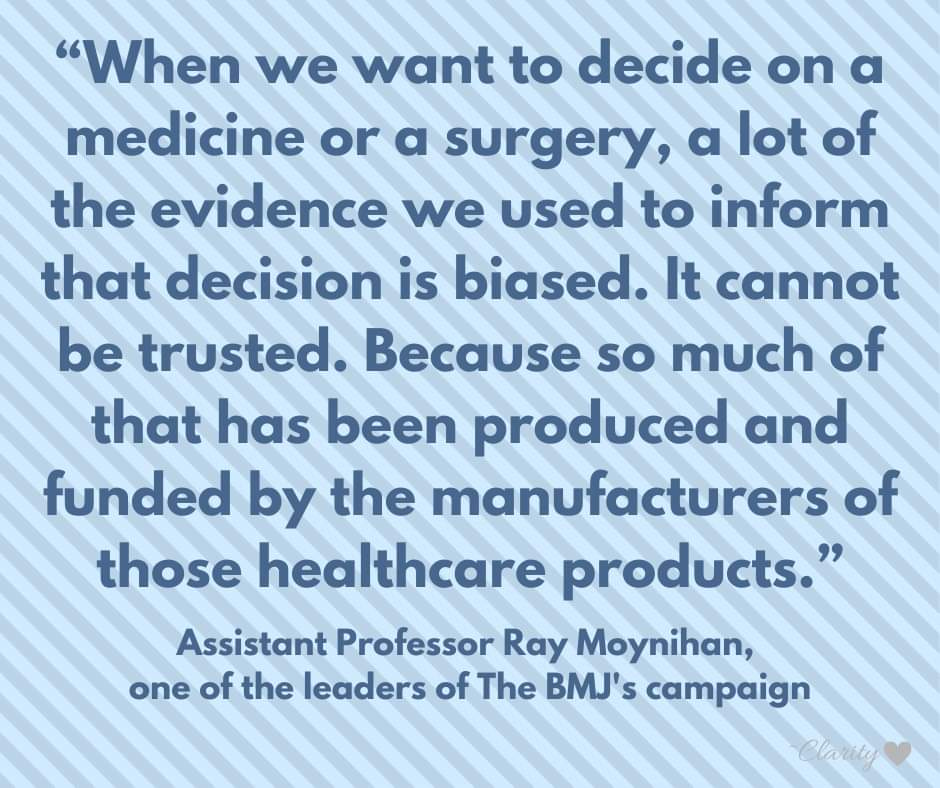
Altman’s editorial is definitely a stinging rebuke of the state of the scientific literature yet the warnings were not heeded by those in a position to do anything about it. Thus, another alarm bell was rung 11 years later in a 2005 essay by Prof. John Ioannidis, a well-reapected Greek-American physician-scientist, writer and Stanford University professor of medicine. In his essay, Prof. Ioannidis discussed simulations which showed that “for most study designs and settings, it is more likely for a research claim to be false than true.” He laid out several reasons for his conclusion which included false-positive findings, inherent biases, lack of testing by several independent teams, small study sizes, too great of flexibility (in study designs, definitions, outcomes, analytical modes, etc.), financial interests and prejudices, and the paradoxical scenario of too many teams working in a “hot” field. Due to these and other factors (which can be found in his article), it was not surprising to Prof. Ioannidis that it could be proven that most research findings are false:
“There is increasing concern that most current published research findings are false. The probability that a research claim is true may depend on study power and bias, the number of other studies on the same question, and, importantly, the ratio of true to no relationships among the relationships probed in each scientific field. In this framework, a research finding is less likely to be true when the studies conducted in a field are smaller; when effect sizes are smaller; when there is a greater number and lesser preselection of tested relationships; where there is greater flexibility in designs, definitions, outcomes, and analytical modes; when there is greater financial and other interest and prejudice; and when more teams are involved in a scientific field in chase of statistical significance. Simulations show that for most study designs and settings, it is more likely for a research claim to be false than true. Moreover, for many current scientific fields, claimed research findings may often be simply accurate measures of the prevailing bias. In this essay, I discuss the implications of these problems for the conduct and interpretation of research.
Published research findings are sometimes refuted by subsequent evidence, with ensuing confusion and disappointment. Refutation and controversy is seen across the range of research designs, from clinical trials and traditional epidemiological studies [1–3] to the most modern molecular research [4,5]. There is increasing concern that in modern research, false findings may be the majority or even the vast majority of published research claims [6–8]. However, this should not be surprising. It can be proven that most claimed research findings are false. Here I will examine the key factors that influence this problem and some corollaries thereof.
https://journals.plos.org/plosmedicine/article?id=10.1371/journal.pmed.0020124
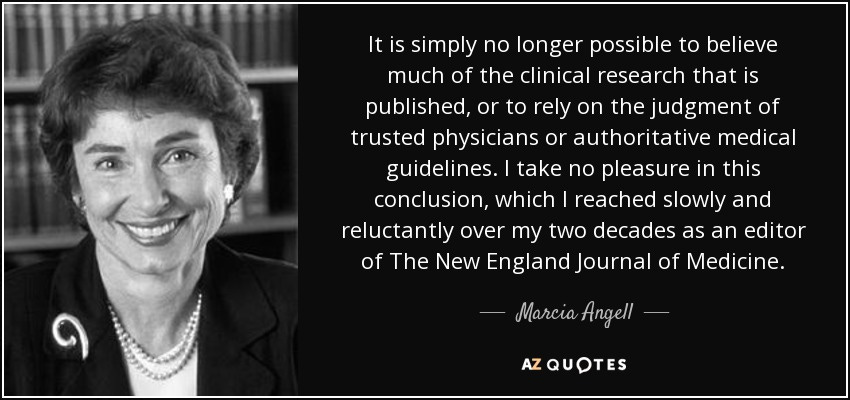
Ten years after Prof. Ioannidis’ article came out, things had not become any better. In fact, it was shown that the problem had only grown worse over time. The sciences are currently embroiled in a reproducibility and replicability crisis where published findings are unable to be verified by independent researchers. In a 2015 article in Big Think, author Simon Oxenham looked at many of these developments since Prof. Ioannidis’ article was published in 2005 and found that his conclusion that most scientific research is false was validated by other researchers. Numerous examples of fraudulent findings are described within the excerpt below:
Ten years ago, a researcher claimed most published research findings are false; now a decade later, his claim is stronger than ever before. How can this be?
“The claim that “most published research findings are false” is something you might reasonably expect to come out of the mouth of the most deluded kind of tin-foil-hat-wearing-conspiracy-theorist. Indeed, this is a statement oft-used by fans of pseudoscience who take the claim at face value, without applying the principles behind it to their own evidence. It is however, a concept that is actually increasingly well understood by scientists. It is the title of a paper written 10 years ago by the legendary Stanford epidemiologist John Ioannidis. The paper, which has become the most widely cited paper ever published in the journal PLoS Medicine, examined how issues currently ingrained in the scientific process combined with the way we currently interpret statistical significance, means that at present, most published findings are likely to be incorrect.
Richard Horton, the editor of The Lancet recently put it only slightly more mildly: “Much of the scientific literature, perhaps half, may simply be untrue.” Horton agrees with Ioannidis’ reasoning, blaming: “small sample sizes, tiny effects, invalid exploratory analyses, and flagrant conflicts of interest, together with an obsession for pursuing fashionable trends of dubious importance.” Horton laments: “Science has taken a turn towards darkness.”
Last year UCL pharmacologist and statistician David Colquhoun published a report in the Royal Society’s Open Science in which he backed up Ioannidis’ case: “If you use p=0.05 to suggest that you have made a discovery, you will be wrong at least 30 percent of the time.” That’s assuming “the most optimistic view possible” in which every experiment is perfectly designed, with perfectly random allocation, zero bias, no multiple comparisons and publication of all negative findings. Colquhorn concludes: “If, as is often the case, experiments are underpowered, you will be wrong most of the time.”
The numbers above are theoretical, but are increasingly being backed up by hard evidence. The rate of findings that have later been found to be wrong or exaggerated has been found to be 30 percent for the top most widely cited randomized, controlled trials in the world’s highest-quality medical journals. For non-randomized trials that number rises to an astonishing five out of six.
Over recent years Ioannidis’ argument has received support from multiple fields. Three years ago, when drugs company Amgen tried to replicate the “landmark publications” in the field of cancer drug development for a report published in Nature, 47 out of 53 could not be replicated. When Bayer attempted a similar project on drug target studies, 65 percent of the studies could not be replicated.
The problem is being tackled head on in the field of psychology which was shaken by the Stapel affair in which one Dutch researcher fabricated data in over 50 fraudulent papers before being detected. The social sciences received another blow recently when Michael LaCour was accused of fabricating data; the case exposed how studies are routinely published without raw data ever being made available to reviewers.
A massive operation titled The Open Science Collaboration, involving 270 scientists, has so far attempted to replicate 100 psychology experiments, but only succeeded in replicating 39 studies. The project looked at the first articles published in 2008 in the leading psychology journals. The news wasn’t entirely bad; the majority of the non-replications were described by the researchers as having at the very least “slightly similar” findings. The resulting paper is currently under review for publication in Science, so we’ll have to wait before we get more details. The paper is likely to ruffle some feathers; tempers flared a few years ago when one of the most high-profile findings of recent years, the concept of behavioral priming, was called into question after a series of failed replications.
Whatever way you look at it, these issues are extremely worrying. Understanding the problem is essential in order to know when to take scientific claims seriously.”

In April 2018, Dr. Jason Fung published an article for Medium which looked at the issues related to the corruption of the scientific data for evidence-based medicine. He noted that, if the claims that most scientific research findings are false turned out to be true, the concept of evidence-based medicine is completely worthless. Dr. Fung looked to editors of the scientific journals, such as Richard Horton of The Lancet as well as Dr. Marcia Angell and Dr. Arnold Relman of the NEMJ, who all stated that the published research in the scientific journals could not be trusted. He pointed out that the research is almost always funded by the pharmaceutical companies and that more often then not, the findings are always favorable to their interests. As the evidence base is heavily tampered with by the incestuous involvement of the companies most likely to benefit, evidence-based medicine as a science is utterly useless. Dr. Fung stated that until the corrupting influence of the pharmaceutical and commercial interests are removed from the equation, there was no way that the scientific results could be believed to be valid. He offered examples of the many problem areas that were in dire need of being addressed such as rigged outcomes, publication biases, financial conflicts of interests, selective publishing, and bribery of the journal editors. Until these and other corrupting influences are resolved, the science can not be trusted:
So, why do prominent physicians call EBM mostly useless? The 2 most prestigious journals of medicine in the world are The Lancet and The New England Journal of Medicine. —Richard Horton, editor in chief of The Lancet said this in 2015
“The case against science is straightforward: much of the scientific literature, perhaps half, may simply be untrue” —Dr. Marcia Angell, former editor in chief of NEJM wrote in 2009 that,
“It is simply no longer possible to believe much of the clinical research that is published, or to rely on the judgment of trusted physicians or authoritative medical guidelines. I take no pleasure in this conclusion, which I reached slowly and reluctantly over my two decades as an editor”
This has huge implications. Evidence based medicine is completely worthless if the evidence base is false or corrupted. It’s like building a wooden house knowing the wood is termite infested. What caused this sorry state of affairs? Well, Dr. Relman another former editor in chief of the NEJM said this in 2002
“The medical profession is being bought by the pharmaceutical industry, not only in terms of the practice of medicine, but also in terms of teaching and research. The academic institutions of this country are allowing themselves to be the paid agents of the pharmaceutical industry. I think it’s disgraceful”
The people in charge of the system — the editors of the most important medical journals in the world, gradually learn over a few decades that their life’s work is being slowly and steadily corrupted. Physicians and universities have allowed themselves to be bribed.
The examples in medicine are everywhere. Research is almost always paid for by pharmaceutical companies. But studies done by industry are well known to have positive results far more frequently. Trials run by industry are 70% more likely than government funded trials to show a positive result. Think about that for a second. If EBM says that 2+2 = 5 is correct 70% of the time, would you trust this sort of ‘science’?”
“Evidence based medicine depends entirely upon having a reliable base of evidence (studies). If the evidence base is tampered with, and paid for, then EBM as a science is completely useless. Indeed, the very editors whose entire careers have been EBM have now discovered it to be worthless. Does the CEO of Phillip Morris (maker of Marlboro cigarettes) smoke? That tells you all you need to know about the health risks. Do the editors of the NEJM and the Lancet believe EBM anymore? Not at all. So neither should we. We can’t believe evidence based medicine until the evidence has been cleaned up from the corrupting influence of commercial interests.”
“So here’s a damning list of all the problems of EBM
- Selective Publication
- Rigged outcomes
- Advertorials Reprint Revenues
- Bribery of Journal Editors
- Publication Bias
- Financial Conflicts of Interests
When the evidence base of medicine is bought and paid for, people die. That is how doctors have created this opioid crisis that kills thousands of people. Pharmaceutical companies want to pay off doctors, just as drug lord want to pay off judges and police officers. Doctors, being human, should put safeguards against this temptation. Unfortunately, doctors and universities have been willing participants in this game of killing for profit. We need to end it now. End the corruption of the universities. Stop the bribery of doctors.”
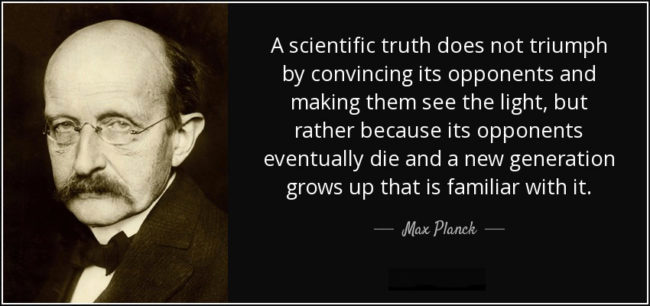
In a July 2021 article for Reason, author Ronald Bailey attempted to figure out how much of the current scientific research could potentially be fraudulent. He provided many examples from the scientific literature such as a 2015 study by the British Acadeny of Medical Sciences which offered a 69% false discovery rate, which could go as high as 90% according to Prof. John Ioannidis. He also supplied a recent Dutch study that saw over 50% of the thousands of scientists surveyed admitting to committing scientific fraud. It was noted that the 51% number may in fact be an underestimate. Thus, the possibility is very realistic that fraud is the driving factor behind the astronomical amount of false research being produced. Former editor of the medical journal The BMJ Richard Smith asked if it’s “time to assume that health research is fraudulent until proven otherwise.” A systematic review of randomized controlled trials from the journal Anaesthesia found that, of the 153 studies for which individual patient data were available, “44 percent had untrustworthy data and 26 percent were what he called ‘zombie’ trials whose results are animated by false data.” Prof. Ioannidis estimated that there are hundreds of thousands of these “zombie” randomized controlled trials out there, and as RCT’s are considered the “gold standard” of scientific research, it is horrifying to think how many more of these kinds of fraudulent studies make up the less stringent research types such as observational studies. It was also pointed out that the problem of false findings is reflected in a system that rewards fraudulent research where journals have no incentive to ensure that the publications are valid. This led Bailey to agree with Smith’s conclusion that it “may be time to move from assuming that research has been honestly conducted and reported to assuming it to be untrustworthy until there is some evidence to the contrary.” In other words, the science can not be trusted:
How bad is the false-positive problem in scientific research? As I earlier reported, a 2015 editorial in The Lancet observed that “much of the scientific literature, perhaps half, may simply be untrue.” A 2015 British Academy of Medical Sciences report suggested that the false discovery rate in some areas of biomedicine could be as high as 69 percent. In an email exchange with me, Ioannidis estimated that the nonreplication rates in biomedical observational and preclinical studies could be as high as 90 percent.
The possibility that fraud may well be responsible for a significant proportion of the false positives reported in the scientific literature is suggested by a couple of new Dutch studies. Both studies are preprints that report the results of surveys of thousands of scientists in the Netherlands aiming to probe the prevalence of questionable research practices and scientific misconduct.
Summarizing their results, an article in Science notes, “More than half of Dutch scientists regularly engage in questionable research practices, such as hiding flaws in their research design or selectively citing literature. And one in 12 [8 percent] admitted to committing a more serious form of research misconduct within the past 3 years: the fabrication or falsification of research results.” Daniele Fanelli, a research ethicist at the London School of Economics, tells Science that 51 percent of researchers admitting to questionable research practices “could still be an underestimate.”
In June, a meta-analysis of prior studies on questionable research practices and misconduct published in the journal Science and Engineering Ethics reported that more than 15 percent of researchers had witnessed others who had committed at least one instance of research misconduct (falsification, fabrication, plagiarism), while nearly 40 percent were aware of others who had engaged in at least one questionable research practice.
In a blistering editorial earlier this week, former editor of the medical journal The BMJ Richard Smith asks if it’s “time to assume that health research is fraudulent until proven otherwise.” Smith calls attention to a systematic review of randomized controlled trials recently submitted to the journal Anaesthesia by British anesthetist John Carlisle. He found that of the 153 studies for which individual patient data were available, 44 percent had untrustworthy data and 26 percent were what he called “zombie” trials whose results are animated by false data. Carlisle pointed out that many of the zombie trials came from researchers in Egypt, China, India, Iran, Japan, South Korea, and Turkey.
In an editorial, Ioannidis observes that the zombie anesthesia trials added up to “100% (7/7) in Egypt; 75% (3/ 4) in Iran; 54% (7/13) in India; 46% (22/48) in China; 40% (2/5) in Turkey; 25% (5/20) in South Korea; and 18% (2/11) in Japan.” Taking the number of clinical trials from these countries listed with the World Health Organization’s registry and extrapolating from the false trial rates identified by Carlisle, Ioannidis estimates that there are “almost 90,000 registered false trials from these countries, including some 50,000 zombies.” Consequently, he concludes that “hundreds of thousands of zombie randomised trials circulate among us.” Since randomized controlled trials are the gold standard for clinical research, Ioannidis adds, “One dreads to think of other study designs, for example, observational research, that are even less likely to be regulated and more likely to be sloppy than randomised trials.”
In his BMJ editorial, Smith cites the work of Barbara K. Redman, author of Research Misconduct Policy in Biomedicine: Beyond the Bad-Apple Approach. During a webinar on research fraud, Smith reported that she insisted “that it is not a problem of bad apples but bad barrels if not of rotten forests or orchards.” Redman argues, according to Smith, “that research misconduct is a systems problem—the system provides incentives to publish fraudulent research and does not have adequate regulatory processes.” The research publication system is built on trust and peer review is not designed to detect fraud. Journals, publishers, funders, and research institutions have little incentive to check for fraud and a big disincentive against damaging their reputations by retracting studies.
So what can be done to stem the tide of apparently fraudulent research? Ioannidis suggests that one useful step would be to require that all datasets must be made available for reanalysis by other researchers. That is how Carlisle was able to identify untrustworthy and zombie anesthesia studies. Some hard thinking needs to be done about how to change incentives from publishing studies to discovering the true things about the world. For the time being, Smith may be right that “it may be time to move from assuming that research has been honestly conducted and reported to assuming it to be untrustworthy until there is some evidence to the contrary.”
https://reason.com/2021/07/09/how-much-scientific-research-is-actually-fraudulent/

While the medical establishment can attempt to rely on the excuse of fast-moving data during the “pandemic” to try and cover up the inherent fraud occurring, it is very apparent that this is not a new problem and is in fact one that has continually evolved over time. The use of the “pandemic” and the hastened, astronomical amounts of unverified research produced therein has only put a brighter spotlight on the issues that have been brewing underneath the surface and ignored for quite some time. Research biases, selective publications, financial conflicts of interests, journal bribery, inappropriate study designs, faulty interpretations, rigged outcomes, etc. have all been a staple of scientific research throughout the decades. Various people have rung the alarm bells over the last few decades yet little to no action has been taken by those in a position to do something about it. False findings have been built upon and compounded throughout the research over the years. When multiple scientists and editors of the scientific journals call out the rampant fraud occurring within their own field, we must take notice and listen. It is time to ignore the oft-repeated “trust the science” mantra and realize that trusting the science is one thing we most certainly should not do unless we can verify the accuracy of the findings for ourselves by way of independent investigation. Until proven otherwise, we must assume that the science is in fact fraudulent.

Moon Maiden Musings had a really nice piece exploring the issues related to the peer review system.
Proton Magic News had a fun look at Fan Wu’s February 2020 sci-fi epic “A new coronavirus associated with human respiratory disease in China.”
Dr Sam Bailey examined the Strep A madness currently making the rounds.
The Way Forward with Alec Zeck had a very powerful conversation with Vinny Tolman, a man declared dead and zipped up in a body bag yet lived to tell of his journey.
Dr. Tom Cowan examined whether Vitamin D is a friend or a foe.
https://www.bitchute.com/video/Cpv1XrGHXBB1/
Dr. Cowan also had an enlightening conversation with Dr. Stefano Scoglio about the “spike protein” and the mRNA injections.
https://drtomcowan.com/blogs/podcasts/58-stefano-scoglio